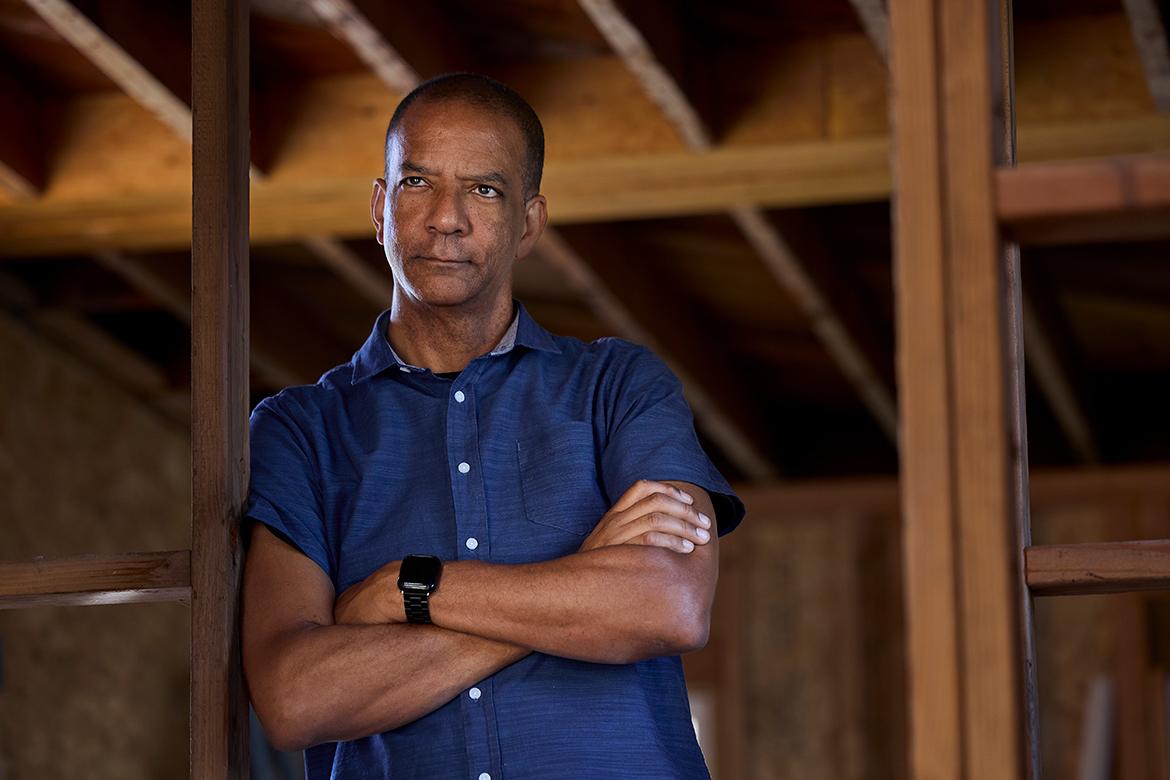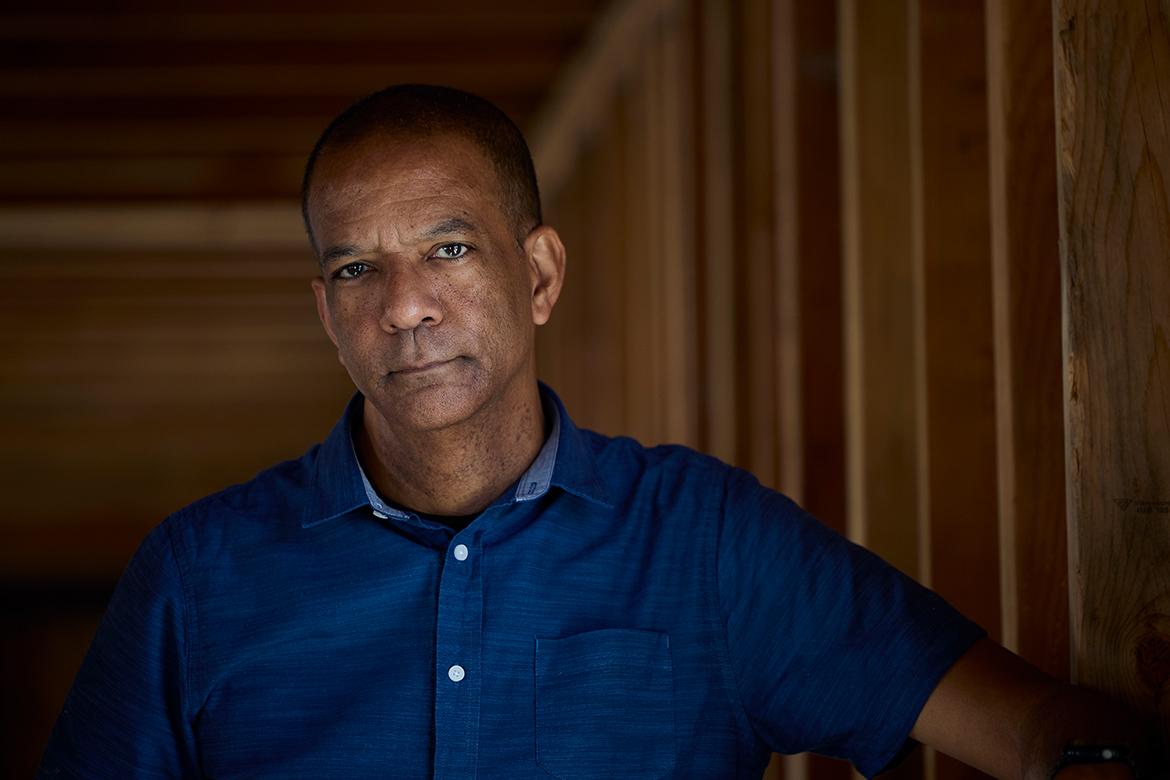Zoom In: Eric Dyson

As seen in the September 2024 issue of ICG Magazine
By David Geffner
Photos by Eric Fischer
Eric Dyson has a history with the Emerging Cinematographer Awards that is unique within ICG. The 2024 ECA entry, Sweet Santa Barbara Brown, shot by Local 600 Operator Dominic J. Bartolone, Jr., SOC, marks the second short film Dyson has premiered at the ECA’s – as a director. (The first, Baby Steps, screened in 2018.)
That’s right. The 30-year IATSE member, who worked his way up from loader to 2nd AC, to 1st AC, and then operator, has also been writing and directing short projects throughout his long career in the camera department. Dyson says the twin inspirations of his father, a jazz musician and amateur black-and-white photographer who had his own darkroom, and his mother, an entrepreneur who started her own payroll company, “was a combination in my home that was the real start of my career in this industry.”
Another big influence was working for Fritz Goode who ran Masai Films, one of the only Black-owned production companies in Hollywood at that time. “Joseph Wilcots, who worked with Fritz, shot the original Roots mini-series,” Dyson shares. “So, being there as a 16-year old was an incredible experience – Fritz would say, ‘This is Eric. He’s going to be a cinematographer.’ Even though I didn’t really know what that was!”
Dyson attended Brooks Institute of Photography on a three-year program, where all students had to buy a four-by-five camera and retouch negatives, regardless of whether their focus was still or motion picture photography. But Dyson says he’s known since high school that moving images were his first love. “My parents bought me a Betamax camcorder in 1985, so I was the AV nerd holding the big camera at high school events,” he describes. “Between that and working for Masai, the roadmap was laid out by the time I got to Brooks and I just kept following in that direction.”
That roadmap also included a three-year stop at Amblin Entertainment, culminating as a set P.A. on the Amblin-produced TV series SeaQuest 2032, shot by Ken Zunder and Stephen McNutt. Of his Amblin days, Dyson says, “Watching Steven Spielberg play with these little dinosaurs [to map out shots for Jurassic Park], and me recording that with a tiny lipstick camera in a kind of ‘early previs,’ was pretty darn cool. So was having Stan Winston show us around his studio, seeing the original puppets for E.T., and getting to take golf carts around the Universal lot to secret places not everyone else knew about.”
Even though Dyson was a P.A. for the A.D. department on SeaQuest, he managed to spend plenty of time with the IATSE camera team – when a film loader went home sick toward the end of the show’s run, Dyson was asked to fill in, earning enough hours to join the union. “These were still the days we’re loading 35-millimeter film in a dark room – the Golden Age of moviemaking,” he smiles.

Dyson’s introduction to the ECA’s came while working as a 2nd AC on Judging Amy. “I was starting to do my own writing at that time,” he remembers. “An operator named Walt Andrus, now retired, said he would love to shoot what I was writing so he could submit it for an ECA. So, when I set about wanting to make my short, I understood that being a union camera technician gave me access to a lot of resources others might not have: Panavision said if you can insure what you need, you can have it; I had an experienced key grip offering to produce it. I knew I had the advantage of all these terrific professional relationships and the trust that comes from them.”
Years passed, with Dyson keeping busy on a run of high-profile shows including 24, Pushing Daisies, Community, Revenge and Extant, before he began writing again. “Baby Steps took about a year-and-a-half to write,” he continues. “The DP was Cliff Jones, a DIT I knew who wanted to shoot as much as possible. We had a great working relationship talking about things like shot design, camera movement and color scheme. Cliff did a fantastic job on Baby Steps with minimal crew and lighting. He embraced the crappy aesthetic of the sets and what the actors were going for – the result was Cliff’s second ECA and now he’s shooting a Disney Channel show.”
Dyson’s next short was a dark comedy called Appy Days. “I hate asking people to work for free twice,” he recounts of bringing Jones back as his DP. “I offered to pay Cliff a little bit this time and he graciously declined. Two years later, I wrote Baggage Claim, which is on the festival circuit now and which Cliff also shot. We’ve done three projects together and each one has gotten smaller, in terms of my trying to use the least amount of dialogue to tell the story.”
Roughly six months after Baggage Claim, Dyson landed a gig on HBO’s Emmy-nominated sports drama Winning Time: The Rise of the Lakers Dynasty [ICG Magazine April 2022]. “Dominic Bartolone [SOC] was the A-Camera operator and he put my name in the hat. I came onto this massive set, with 500 extras, as one of 10 to 12 operators, and everyone on headsets. At some point, Dom said I should speak to Solomon Hughes [Kareem Abdul Jabbar in the series], as he had a short he wanted to do. It was about a racial profiling incident in the early 80s with the Harlem Globetrotters, in Santa Barbara, California. After he wrote it, Solomon, me, Dom, and some other folks started having Zoom meetings about how to bring this story to life.”
The film shot on King Gillette Ranch in Calabasas, CA, and at a church in Pasadena, CA, which presented Bartolone with some “moody interiors to light,” as Dyson describes, and at least one major action scene involving drawn guns, police cars, background players and more. “Because Dom and I have had so many years in the trenches,” he adds, “we knew exactly how to light, stage and just generally approach a scene like that in the most efficient way possible. Of course, we knew to have an armorer on set and follow all gun-safety procedures to the letter, because we’ve all been on so many shows that have guns.
“We’ve also had our fair share of less-than-great productions,” Dyson continues, “so just making sure everyone broke for lunch on time and was done when the schedule says they’re supposed to be done made our Santa Barbara crew happy. Show up, do your job, and be respectful of all your other union brothers and sisters on set, is what people like me and Dom, who have put in so many hours, bring to a film like this. I think the result – ECA recognition by your ICG peers – speaks for itself.”
Another thing Dyson says camera pros like Jones and Bartolone bring to an ECA-winning production is having hands-on experience with new technologies. “If you’ve been a first, a second, a DIT or an operator, you’ve dealt directly with rental houses, you’ve broken down cameras, you know exactly what new lens, or rig or accessory will work best,” he explains. “So when you get the opportunity to DP, you can now use that technology you know so much about in the most creative way possible.”
Dyson says he’s become painfully aware – over the years – of the lack of racial and gender diversity in the camera department, but it wasn’t always so. “Growing up on sets run by Fritz Goode or [ICG Director of Photography] Johnny Simmons [ASC], it never occurred to me that wasn’t the norm,” he laughs. “It wasn’t until working on SeaQuest as a P.A. that I realized I was usually the only person of color on the set.”
Consequently, Dyson adds, “Working alongside people like Johnny Simmons; Todd A. Dos Reis [ASC], who was an ECA winner; Kirk Gardner; and Emil Hampton has given me a template for how to be a professional in this industry.
“I was a second when Cynthia Pusheck, who’s another ECA winner, was working for Pete Romano. Cynthia left to go to AFI, and later, when she became a director of photography, I worked for her as a focus puller. There weren’t many female DP’s, certainly not in television, when Cynthia started, just like there weren’t many Black operators. So, not only did all of these people I mentioned provide mentorship, but I formed long-lasting relationships with them from which I have drawn so much knowledge and tried to pass it forward.”
